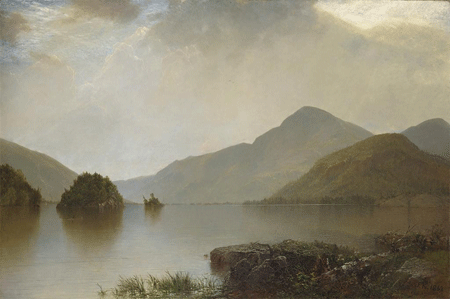Art at the bedside: Research on the healing potential of the visual arts

John Frederick Kensett | Lake George, 1869 | The Metropolitan Museum of Art | Image © The Metropolitan Museum of Art
Susan Dodge-Peters Daiss
McPherson Director of Education
Memorial Art Gallery of the University of Rochester
The idea of bringing works of art to the bedside of patients in the hospital emerged from two interwoven aspects of my professional life: for over 25 years, I have worked as a museum educator at the Memorial Art Gallery of the University of Rochester. I have also been trained and have served as a hospital and hospice chaplain. During my experiences as a chaplain, I began to wonder: What if the energy encountering artwork in a museum could be transported to the bedside? What if the visual arts had the potential to bring more than decoration to medical settings? What if they could bring comfort—deep comfort, and maybe even more?
The research:
I have been engaged in delivering Art at the Bedside for nearly three years. Permission to engage with patients with this idea was granted initially in the division of Palliative Care at Strong Memorial Hospital, the University of Rochester.
The idea is simple: from Artstor’s vast storehouse of images, I have a series of pre-selected images that I bring with me in a computer to visit patients and their families. My initial image selection focused exclusively on scenes from the natural world. Over time, responding to patient requests, I’ve added images of Norman Rockwell, angels, the season, etc. The current eclectic mix seems to satisfy the sensibilities of the diversity of patients served in the hospital.
I developed a visual menu to introduce the idea to patients. The selections are intentionally short—rarely more than a dozen images in length. Many variables affect the nature and length of the experience, from the number of individuals participating to the state of the patient’s condition at the time of my visit.
My experiences to date have fallen under several overlapping categories. (Comment in italics.)
- Diversion/Distraction: Looking at images of clouds, one patient said, “I love looking at clouds. Clouds give me a place to put my pain.”
- Reminiscences/Reflections: Although the patient was not responsive, the family gathered around the computer to look at the images: “Look, doesn’t this remind you of the road to the country? Isn’t that just like…” describing a place they all knew “…Daddy would have loved this.”
- “Right now, I’m on this side of the glass. I’m headed back to the other side of the glass. These pictures bring the world from the other side of the glass in here.”
- Images as metaphors: From a woman who knew she was dying, “I’m glad that all your landscapes aren’t green.”
Next steps:
It is time to share the idea and potential of Art at the Bedside. Currently I am writing a reflection on this research for submission to several medical journals, and I am planning to submit Art at the Bedside as a presentation topic at several medical humanities conferences.
Postscript:
The article mentioned above was published in 2016:
Dodge-Peters Daiss S. Art at the Bedside: Reflections on Use of Visual Imagery in Hospital Chaplaincy. J Pastoral Care Counsel. 2016 Mar;70(1):70-9. doi: 10.1177/1542305015618170. PMID: 26956753. https://pubmed.ncbi.nlm.nih.gov/26956753/


